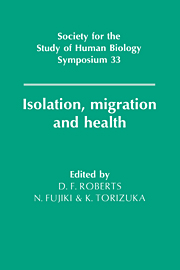Book contents
- Frontmatter
- Contents
- List of contributors
- Preface
- 1 The legacy of the IBP: Presidential Address
- 2 The distinction between primary and secondary isolates
- 3 Time trends in the break-up of isolates
- 4 Factors influencing the frequency of consanguineous marriages in Japan
- 5 Break-up of isolates
- 6 Isolates in India: their origin and characterisation
- 7 Consanguineous marriages and their genetical consequences in some Indian populations
- 8 Biomedical and immunogenetic variation in isolated populations in India
- 9 Genetic distance analyses in Israeli groups using classical markers and DNA polymorphisms in the β globin gene
- 10 Non-random distribution of Gm haplotypes in northern Siberia
- 11 Allele frequency estimation
- 12 Genetic affinities of human populations
- 13 Inherited neurological diseases in island isolates in southern Japan
- 14 Serological and virological evidence for human T-lymphotropic virus type I infection among the isolated Hagahai of Papua New Guinea
- 15 Analysis of genes associated with hypercholesterolaemia in the Japanese population
- 16 Migrant studies and their problems
- 17 Tokelau: migration and health in a small Polynesian society - a longitudinal study
- 18 Micromigrations of isolated Tuareg tribes of the Sahara Desert
- 19 Population structure in the eastern Adriatic: the influence of historical processes, migration patterns, isolation and ecological pressures, and their interaction
- 20 Diabetes and diabetic macroangiopathy in Japanese-Americans
- 21 Diabetes and westernisation in Japanese migrants
- 22 Environmental factors affecting ischemic heart disease
- Epilogue
- Index
14 - Serological and virological evidence for human T-lymphotropic virus type I infection among the isolated Hagahai of Papua New Guinea
Published online by Cambridge University Press: 05 March 2012
- Frontmatter
- Contents
- List of contributors
- Preface
- 1 The legacy of the IBP: Presidential Address
- 2 The distinction between primary and secondary isolates
- 3 Time trends in the break-up of isolates
- 4 Factors influencing the frequency of consanguineous marriages in Japan
- 5 Break-up of isolates
- 6 Isolates in India: their origin and characterisation
- 7 Consanguineous marriages and their genetical consequences in some Indian populations
- 8 Biomedical and immunogenetic variation in isolated populations in India
- 9 Genetic distance analyses in Israeli groups using classical markers and DNA polymorphisms in the β globin gene
- 10 Non-random distribution of Gm haplotypes in northern Siberia
- 11 Allele frequency estimation
- 12 Genetic affinities of human populations
- 13 Inherited neurological diseases in island isolates in southern Japan
- 14 Serological and virological evidence for human T-lymphotropic virus type I infection among the isolated Hagahai of Papua New Guinea
- 15 Analysis of genes associated with hypercholesterolaemia in the Japanese population
- 16 Migrant studies and their problems
- 17 Tokelau: migration and health in a small Polynesian society - a longitudinal study
- 18 Micromigrations of isolated Tuareg tribes of the Sahara Desert
- 19 Population structure in the eastern Adriatic: the influence of historical processes, migration patterns, isolation and ecological pressures, and their interaction
- 20 Diabetes and diabetic macroangiopathy in Japanese-Americans
- 21 Diabetes and westernisation in Japanese migrants
- 22 Environmental factors affecting ischemic heart disease
- Epilogue
- Index
Summary
Introduction
Although human T-lymphotropic virus type I (HTLV-I) was the first human retrovirus to be isolated and the first to be shown to cause a human cancer, adult T-cell leukaemia/lymphoma (ATLL), its importance was overshadowed by the isolation and identification of human immunodeficiency virus as the cause of the acquired immunodeficiency syndrome. A resurgence of interest in HTLV-I, a member of the oncovirinae subfamily of the family Retroviridae, occurred after the fortuitous discovery that patients with endemic tropical spastic paraparesis (TSP) in Martinique had serological evidence of HTLV-I infection (Gessain et al., 1985). Confirmatory data demonstrating IgG antibodies against HTLV-I in sera and cerebrospinal fluids (CSF) of patients with TSP were soon reported from Jamaica (Rodgers-Johnson et al., 1985, 1988), Colombia (Rodgers-Johnson et al., 1985; Zaninovic, 1987), Trinidad (Bartholomew et al., 1986), the Seychelle Islands (Roman et al, 1987) and West Africa (Gessain et al., 1986; Tournier-Lasserve et al., 1987). In addition, patients with a TSP-like disease in southern Japan, designated HTLV-I-associated myelopathy (HAM) (Osame et al., 1987), were found to be infected with HTLV-I. TSP and HAM are now known to represent the same clinical syndrome and are collectively called TSP/HAM, although the term HTLV-I myeloneuropathy seems more appropriate (Rodgers-Johnson et al., 1990).
Since 1983, we have intensified our search for high-prevalence foci of HTLV-I infection, concentrating primarily on isolated populations of the western Pacific.
- Type
- Chapter
- Information
- Isolation, Migration and Health , pp. 143 - 153Publisher: Cambridge University PressPrint publication year: 1992



